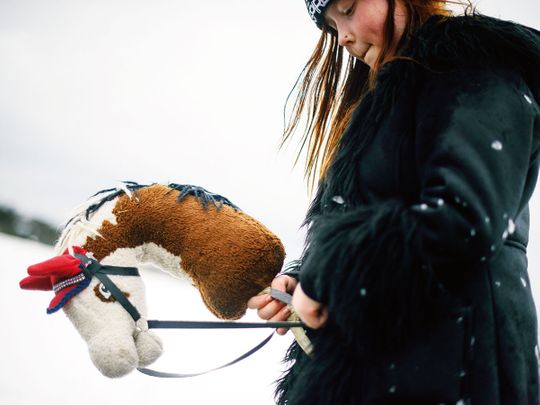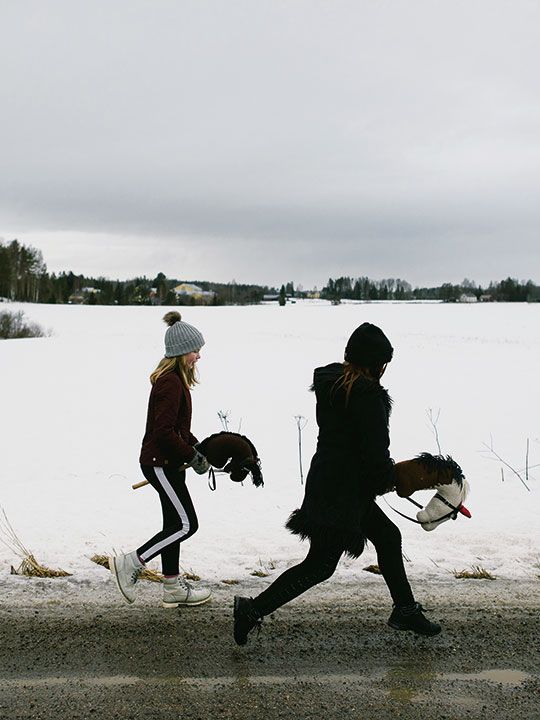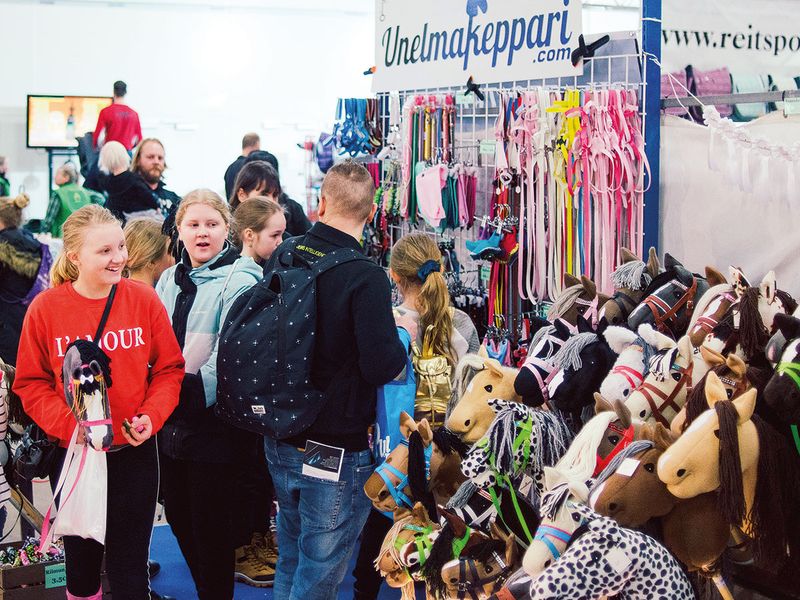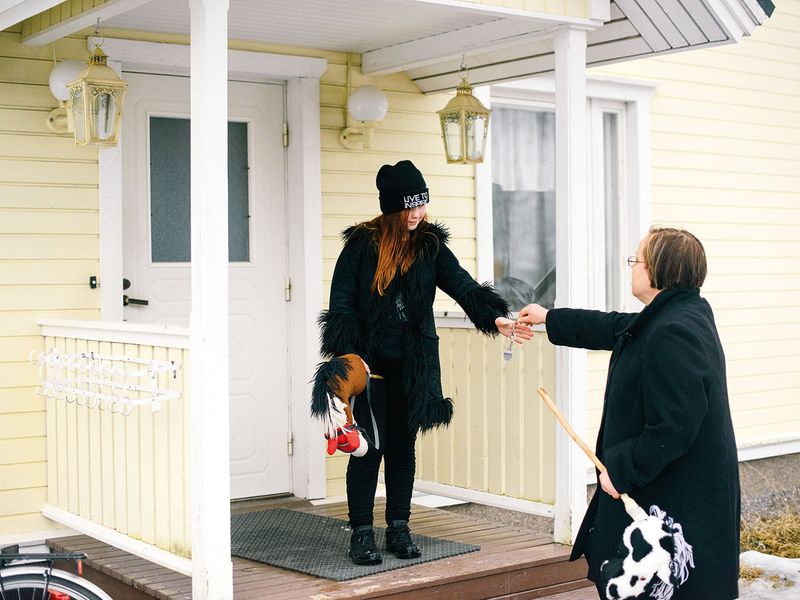
HELSINKI: A dozen girls waited in line in a Helsinki arena for the dressage competition, ready to show off their riding skills, their faces masks of concentration.
The judge put them through their paces — walk, trot, canter — and then asked them for a three-step rein-back, that classic test of a dressage horse’s training and obedience. The judge looked on gravely, occasionally taking notes.
If anyone thought it strange that the girls were riding sticks, no one let on. The make-believe world of the hobbyhorse girls extended as far as the eye could see.
A veterinarian lectured girls on hobbyhorse vaccination schedules, saying “check that the eyes are clear and there is no nasal discharge.” The girls discussed hobbyhorse bloodlines and hobbyhorse temperaments, hobbyhorse training routines and hobbyhorse diets. There were rhinestone-studded bridles for sale.

Among those listening was Fanny Oikarinen, 11, who lives in a village north of Helsinki, Finland’s capital. Fanny is serious, with long red hair and a tiny silver stud in her nose. Fifth grade has brought the dizzying social stratification of adolescent girls, the sudden and vital importance of being cute and popular. Fanny said she does not see much point in this.
“The normal things, that normal girls like, they don’t feel like my things,” she said.
But she is at home in the world of hobbyhorses, where boys and grown-ups have no place.
Fanny and her friend, Maisa Wallius, are training for summertime competitions. They have choreographed a two-part dressage routine to a song by Nelly, the rapper. Asked which types of girls are drawn to hobbyhorses, Maisa thinks for a while before answering.
“Some are sports girls,” she said. “Some are really lonely girls. And some can be the coolest girl at school.”
It is impossible to say exactly when the Finnish hobbyhorse craze began, because it spread for years under the radar before adults became aware of it.
Little girls are allowed to be strong and wild. I think the society starts to shape them into a certain kind of quietness when they reach puberty.
In 2012, a filmmaker, Selma Vilhunen, stumbled across internet discussion boards used by hobbyhorse enthusiasts and was enraptured.
Teenage girls had invented a form of hobbyhorse dressage, in which the rider’s lower body pranced and galloped like a horse, while her upper body remained erect and motionless like a rider. This evolved into an elaborate network of coaches and students and competitions, but it was discussed only online, for the most part.
“It was like a secret society,” Vilhunen said.
One of the girls she sought out as a guide to the hobbyhorse scene was Alisa Aarniomaki, a teenager from a city on Finland’s west coast.
Leather-jacketed and fuchsia-haired, Aarniomaki was a celebrity in the online world for her hand-sewn hobbyhorses and riding videos, but she was apprehensive about letting her classmates know about it. When she was 12, some friends happened to spot her practicing in the woods near her school, and teased her for playing a child’s game.
“It didn’t fit with their idea of a 12-year-old girl,” she said. “They said I would never get a boyfriend.”
When Vilhunen’s documentary film, Hobbyhorse Revolution, was released in 2017, it captured its subjects in long spells of raucous joy. This was important to the filmmaker, who has made adolescent girls the focus of much of her work.
“Little girls are allowed to be strong and wild,” she said. “I think the society starts to shape them into a certain kind of quietness when they reach puberty.”

The hobbyhorse pastime is now celebrated as a national export, with national championships held every summer and Aarniomaki as its unofficial spokeswomen.
Aarniomaki has been invited to give demonstrations in Sweden, Russia and the Netherlands, all places where the hobby is taking off.
Finland’s Ministry of Foreign Affairs asked her to make hobbyhorses for George and Charlotte, the children of Britain’s Prince William.
Once, she was invited to a party in France where adult guests were given hobbyhorses, provided as a way, she said, “to run away from your boring and maybe exhausting normal life.” The one thing that drives her crazy, she added, is when people describe her hobbyhorse pursuit as playing.
“If someone says we are playing, it strips away everything we made, it strips away the reality,” said Aarniomaki, now 22 and living in Helsinki with her boyfriend.
But within the rapidly expanding community of enthusiasts, the problem of ridicule really doesn’t come up. “I haven’t run into that sort of situation in a long time,” she said. “I live in a bubble that is filled with hobbyhorses.”
By the time Fanny reached adolescence, this hobbyhorse community was in place to welcome her.
She attends a village elementary school with 24 children in her fifth-grade class, mostly the same ones she has known since kindergarten.
Increasingly, she feels different from the girls she grew up with. She listens to heavy metal, and two years ago, she decided she was a goth, and dressed in black, fluttery clothing. Puberty arrived. She began to correspond in English with people she calls “internet friends,” whom she had met in forums for metal groups she likes.
“I don’t have many friends,” she said. “Sometimes I think I would like to be more popular.”

Her friend Maisa, too, was going through changes, giving away the last of her Barbies and Legos. She spent more time on her phone.
“They are at this age where they don’t play anymore,” said Maisa’s mother, Titta Savolainen. “You can see them becoming teenagers.”
It was against this backdrop that Fanny purchased her first hobbyhorse for 24 euros, or about $27, a dappled Arabian mare that she named Amanda.
She felt immediately that she had found, as she put it, her “thing.”
“I have many friends who are interested in it, too, so I knew I wasn’t alone,” Fanny said. “I can be as childish as I want to be.”
On a recent afternoon, the two girls trudged home through the wet snow.
Then Maisa brought over Tarzan — “He is a very gentle horse, he learns fast, and he really loves to jump” — and the two girls set out into the cold.
They broke into a run, pounding the slush with their boots. Then they cut into the forest into deep snow.
They galloped through stands of straggly pines until their cheeks burnt. They knew the terrain by heart, running along pathways that were invisible under the snow.
They ran for an hour, laughing all the way, and were ready to go on much farther into the forest. They would have, if their mothers hadn’t called them home.











